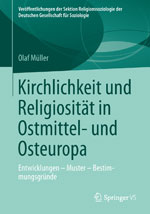The book explores the recent state and development of churchliness and religiosity from three perspectives (decline, individualization, and (re)vitalitazion) and according to three theoretical approaches (secularization theory, individualization thesis, and supply-side model of religious competition). The main questions which are addressed are: What was the situation concerning churchliness and religiosity immediately after the breakdown of communism, and how has it developed during the following two decades? What patterns of religious change can be observed? How can the patterns and differences be explained? The empirical part of the book contains results from micro and macro analyses of a core of 18 countries, which can be classified according to their dominant religious tradition: Catholic – Poland, Slovakia, Croatia, Lithuania, Slovenia, Hungary, Czech Republic; Protestant – Latvia, Estonia, East Germany; Orthodox – Romania, Bulgaria, Serbia, Moldova, Russia, Ukraine; Muslim – Bosnia, Albania. The findings are drawn primarily from various international population surveys (EVS/WVS; ISSP; ESS; Aufbruch; PCE 2000), but also from other religious and structural data.
The central results can be summarized as follows: overall, in terms of change in the religious sphere, no homogenous pattern can be established for the whole region. While most Orthodox societies have experienced a clear religious growth, the situation in Catholic and Protestant countries has been very varied. Indeed, in countries such as the Czech Republic and East Germany, the process of secularization since the political upheavals in the early 1990s seems to be even more advanced. As far as the ability of the theoretical models to explain religious change is concerned, there is no evidence to support the theory of religious competition. In contrast, the individualization thesis can certainly claim a degree of plausibility for itself, although some findings do contradict its assumptions. All in all, a context-sensitive secularization-theory approach, one which looks at specific cultural and political developments, seems best able to explain developments in the field of religion in Central and Eastern Europe.


